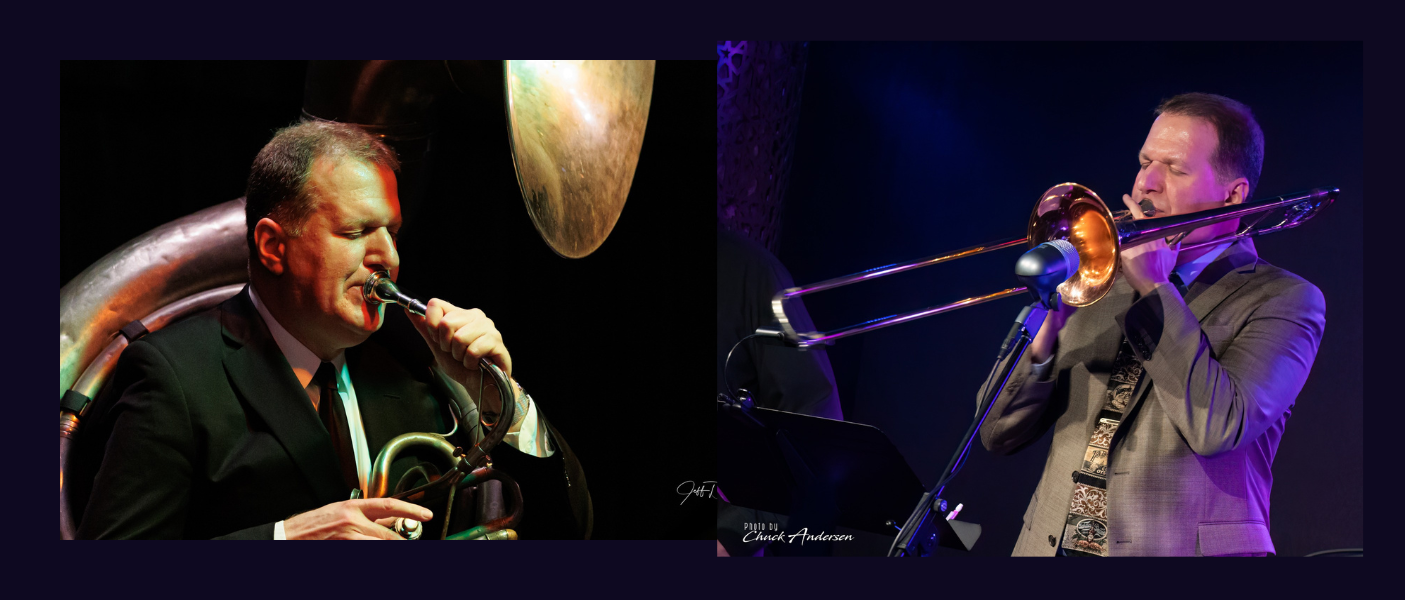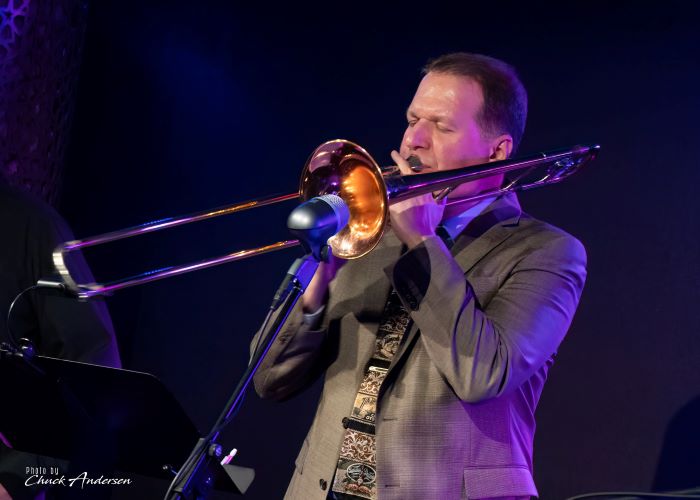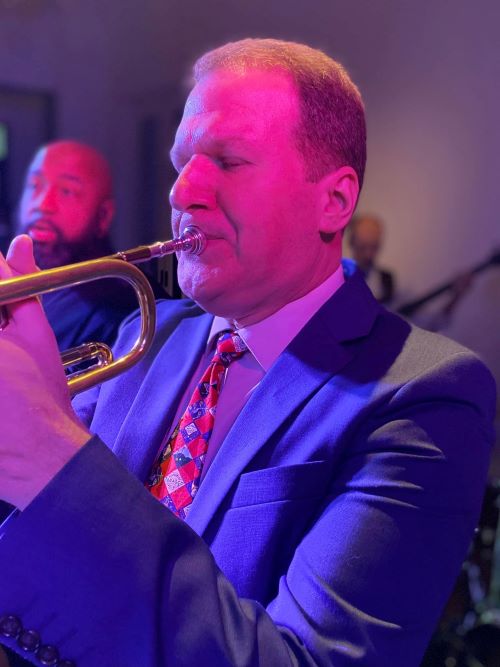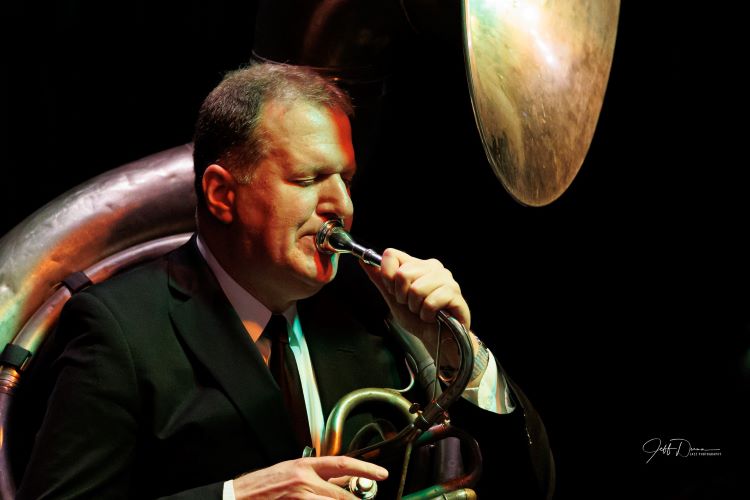

The variety and depth of talent in the Department of Pathology never ceases to amaze. Recently, we spoke with one of our talented staff members, Chris Smith, logistics coordinator for Pathology Supply Inventory. “I am one of at least three people at the University with that name, but the other guys are imposters,” he joked. Smith has been with the department for more than 28 years in a part-time role. His full-time position is that of a professional musician.
 A musician friend mentioned an opening in the department to him, and he jumped at the opportunity to work part-time and receive benefits. “Most musicians are not lucky enough to have insurance or a retirement plan. It sounded like something I could do and was very beneficial.” Smith started in an earlier iteration of the role he currently fills with his work partner, Brooks Barnes, who, not coincidentally, is also a musician. Over the years, the job’s responsibilities and titles have changed as the department expanded and technology changed. “A lot of people think our job is to stock the Kleenex. And it is true; we take care of the Kleenex and other general supplies. That alone is substantial if you walk around the labs and see what is in play. But the job is much bigger than that. We have satellite sites in Brighton, Northville, and many MLabs locations. We send them the necessary supplies, especially reagents and other things for the big analyzer lines.”
A musician friend mentioned an opening in the department to him, and he jumped at the opportunity to work part-time and receive benefits. “Most musicians are not lucky enough to have insurance or a retirement plan. It sounded like something I could do and was very beneficial.” Smith started in an earlier iteration of the role he currently fills with his work partner, Brooks Barnes, who, not coincidentally, is also a musician. Over the years, the job’s responsibilities and titles have changed as the department expanded and technology changed. “A lot of people think our job is to stock the Kleenex. And it is true; we take care of the Kleenex and other general supplies. That alone is substantial if you walk around the labs and see what is in play. But the job is much bigger than that. We have satellite sites in Brighton, Northville, and many MLabs locations. We send them the necessary supplies, especially reagents and other things for the big analyzer lines.”
Initially, all the deliveries came to him in the hospital, where they were distributed, but as the health system expanded, the volumes of supplies needed also increased. Soon, they ran out of space. “The department began to employ a warehouse on the south side of town, Michigan Computer Supplies. Now, we work with MCS; we order necessary items, which are shipped to them, and they then ship these supplies to the MLabs and satellite sites throughout the state.” Nearly every reagent, pipette tip, glassware, glove, test tube, and slide runs through Path Inventory (formerly Path Stores). In addition, the logistics team manages all the off-site record storage. Contents of boxes are managed and recorded before shipping them to our off-site Corrigan warehouse. If a record needs to be accessed again, Smith and his colleagues identify which box the item is in, where the box is in the warehouse, and then they retrieve it and deliver it where needed. They also do a million other small and large tasks to keep the department running smoothly; for example, Path Inventory works with vendors to supply the hundreds of thousands of custom Pathology specimen baggies which are omnipresent in both UH and NCRC.
“Chris has been a steady presence in the Department of Pathology for over two decades, and a large contributor of the unending effort behind the scenes to make the everyday work smooth and disruption-free for our clinical labs,” commented Mike McVicker, Administrative Manager for Clinical Operations.
Outside Pathology, Smith can often be heard performing Jazz and many other musical genres with well-known musicians nationwide, as well as leading his own groups. Smith’s parents and grandparents were from New Orleans, and he grew up as the oldest of 12 children. His grandmother and his father were professional musicians in New Orleans, before the family relocated to Michigan. “Several of my siblings are very, very musically talented, but I’m the only one who stuck with it. It is funny, too, because I don’t feel like I’m the one with the talent in the family. I was simply more determined than they were to stick with it.” In addition to music, his siblings are also artistically talented in the visual arts. “My two daughters are also very artistic and musical,” he added.
"I went into the shed, practicing for two solid years
for many, many hours every single day.”
--Chris Smith
Describing his path to becoming a professional musician, Smith always had a feeling he was going to be a musician as he grew up, but it wasn’t until he was 21 years old that he decided he was going to truly give it a shot to become a professional. “I started a period of what musicians call ‘going into the shed.’ Jazz musicians talk about going into the woodshed to practice. So, I went into the shed, practicing for two solid years for many, many hours every single day.” He knew from reading jazz history that this is what all the greats did; it was a necessary part of his development. At the time, he was working in pizza restaurant, and the store owner allowed him to come in after closing at night to practice. “It was actually the building where Tom Monaghan had his first Domino’s Pizza store.” It was a cinderblock building, which made his brass instruments reverberate like he was in a concert hall. “I would work all afternoon and evening, then the store would close, everyone else would go home, and I would stay and practice till morning. Then, I would go home and sleep for a few hours before coming back. I did that for two years.” One night, as he played with eyes closed, concentrating on his music, he opened them to see a police officer standing outside the window, shining his light on him. “Eventually, they got used to my being there, and would wave when they made their rounds and checked on the store.”
 At one point, Smith decided he wanted to teach music, but had never attended college. “So I went to college and quickly earned three degrees in music while still working here. An undergrad classical performance degree at EMU, then two graduate degrees at the University of Michigan; one in jazz performance, one in historical musicology. “Only musicologists can tell you what that discipline involves. It combines the study of music history, sociology, music theory, performance, and other things, all wrapped around understanding music both as finely and broadly as possible. Musicologists are the people who teach music history, music appreciation, and those types of courses in universities.” He has taught music majors at Siena Heights University, Adrian College, and since 2010, at the University of Michigan School of Music, Theater, and Dance. “I’m probably the only person in Pathology who has also had an appointment at the School of Music,” he laughed. He teaches a special course in the Theory department, but occasionally is asked to do more. For example, he conducted two U-M Jazz Ensemble concerts of early big band music at Rackham Auditorium last year, for which he arranged all of the music. “The students at the University of Michigan School of Music are absolutely among the best in the world. Even though it is a public university, the School of Music, Theater, and Dance is of conservatory quality. It is as good as any music school anywhere.”
At one point, Smith decided he wanted to teach music, but had never attended college. “So I went to college and quickly earned three degrees in music while still working here. An undergrad classical performance degree at EMU, then two graduate degrees at the University of Michigan; one in jazz performance, one in historical musicology. “Only musicologists can tell you what that discipline involves. It combines the study of music history, sociology, music theory, performance, and other things, all wrapped around understanding music both as finely and broadly as possible. Musicologists are the people who teach music history, music appreciation, and those types of courses in universities.” He has taught music majors at Siena Heights University, Adrian College, and since 2010, at the University of Michigan School of Music, Theater, and Dance. “I’m probably the only person in Pathology who has also had an appointment at the School of Music,” he laughed. He teaches a special course in the Theory department, but occasionally is asked to do more. For example, he conducted two U-M Jazz Ensemble concerts of early big band music at Rackham Auditorium last year, for which he arranged all of the music. “The students at the University of Michigan School of Music are absolutely among the best in the world. Even though it is a public university, the School of Music, Theater, and Dance is of conservatory quality. It is as good as any music school anywhere.”
 As a jazz musician specializing in brass, Smith plays the trombone, trumpet, and tuba or sousaphone professionally. “Many people don’t know what it takes to be a jazz musician; we generally figure about 50,000 hours of practice are required to become competent.” Smith put in the time many years ago at the pizza place, and has played (and recorded) with numerous bands and groups over the years. He was with Detroiter Marcus Belgrave’s very popular band for fifteen years, touring the US, Canada, and the Caribbean. He toured the U.S. and Canada with James Dapogny, and Europe with other bands. In 2024, he played with the Preservation Hall Band in New Orleans, and arranged a piece for the Michigan Philharmonic (a symphony orchestra), with which Brooks Barnes performs. At the time of this writing, Chris was leaving for a tour with the Temptations and the Four Tops. “I’ve been a part of their ‘Midwest horn section’ for many years, and it is always a blast to play with these legendary groups.” Other names people may recognize that Smith has performed with include Aretha Franklin, Frankie Valli, the Count Basie Orchestra, the Jimmy Dorsey Orchestra, the Tommy Dorsey orchestra, the Dorsey Brothers Orchestra, the Harry James Orchestra, the Gene Krupa Orchestra, the Glenn Miller Orchestra, and many others. He also plays in symphony orchestras, in brass quintets and quartets – you name it! In addition, Smith arranges and composes music for many groups, including the 1920s-30s dance band called P.O.R.K., which he leads at Ann Arbor’s Zal Gaz Grotto on Sundays, and Aguanko, a Latin jazz band that can often be seen and heard at Ann Arbor’s Blue Llama jazz club. He is also currently the music contractor for special events at the Detroit Athletic Club.
As a jazz musician specializing in brass, Smith plays the trombone, trumpet, and tuba or sousaphone professionally. “Many people don’t know what it takes to be a jazz musician; we generally figure about 50,000 hours of practice are required to become competent.” Smith put in the time many years ago at the pizza place, and has played (and recorded) with numerous bands and groups over the years. He was with Detroiter Marcus Belgrave’s very popular band for fifteen years, touring the US, Canada, and the Caribbean. He toured the U.S. and Canada with James Dapogny, and Europe with other bands. In 2024, he played with the Preservation Hall Band in New Orleans, and arranged a piece for the Michigan Philharmonic (a symphony orchestra), with which Brooks Barnes performs. At the time of this writing, Chris was leaving for a tour with the Temptations and the Four Tops. “I’ve been a part of their ‘Midwest horn section’ for many years, and it is always a blast to play with these legendary groups.” Other names people may recognize that Smith has performed with include Aretha Franklin, Frankie Valli, the Count Basie Orchestra, the Jimmy Dorsey Orchestra, the Tommy Dorsey orchestra, the Dorsey Brothers Orchestra, the Harry James Orchestra, the Gene Krupa Orchestra, the Glenn Miller Orchestra, and many others. He also plays in symphony orchestras, in brass quintets and quartets – you name it! In addition, Smith arranges and composes music for many groups, including the 1920s-30s dance band called P.O.R.K., which he leads at Ann Arbor’s Zal Gaz Grotto on Sundays, and Aguanko, a Latin jazz band that can often be seen and heard at Ann Arbor’s Blue Llama jazz club. He is also currently the music contractor for special events at the Detroit Athletic Club.
However, his most treasured partnership is with his wife, Irina, who came to the U.S. from Ukraine thirty years ago. “My talents are nothing compared to hers; she can do so many things so well, it’s just astonishing. Every day I’m learning something new that she knows or can do. We met in late 2021 after I had a bad accident which required a serious leg operation. Working in Specimen Processing, she saw me limping around the lab in an air cast and began inquiring about how I was doing. One day we talked a little more and had an instant connection - inseparable since then, we were married in March, 2024.” Irina introduced him to traveling for vacations, often with historical interest, not just to see the inside of a music hall. “She has taught me the importance of stopping to smell the roses.” Between his treasured time with his wife, playing music, arranging scores, work, and teaching, Smith’s days and nights are full. He plays in Ann Arbor and Detroit frequently. If you ever have a chance to see him play, I encourage you to go and have fun enjoying his music. You won’t be disappointed!